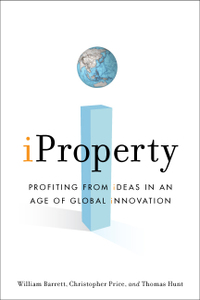
They call this new vision the world of iProperty. The “i” in iProperty does not stand for internet as one might imagine but for a whole thesaurus full of i-words: intellectual, imagination, ideation, insight, innovation, international, intangible and integration.
iProperty is about competing in the future where innovative companies must use intellectual property to protect their valuable ideas. This is a world where stock purchases are not based on factories and inventories but on the innovation and technology embedded within the company’s patent portfolio.
iProperty is defined as:
It is the spirit of outside-the-box thinking that includes intellectual property concepts and a host of other ideas as well. iProperty is best thought of as a set of visionary concepts, strategies, and tactics used by companies for establishing ownage of their ideas in a manner that undergirds and prolongs their competitive success in the global economy.
Thankfully, the book in not totally filled with business-speak. Once in to the meat of the book, you connect the ideas that innovation is happening everywhere. While scaring the bejeebers out of you with the fact that highly skilled innovators are now creating new technologies in thousands of locations around the world, it lays down practical advice as to how business managers can suck it up and start putting the protection and enforcement of ideas into this global context.
Self-described as answering the question, “If I’m serious about strategically deploying intellectual property in a way that benefits my bottom line, what should I do on Monday morning to make that happen?” iProperty tries to set out the concrete details involved in actual implementation and provides executives, managers and attorneys with practical advice for developing and executing a strategic intellectual property plan that will yield a measurable return on investment.
The book also points out that patent attorneys — as gifted as they are — may not always be the best trained to integrate the company’s business strategy with its iProperty strategy. In order to be successful, all of the key players from legal to management, must understand (and buy-in) the iProperty strategy. This means that everyone needs to have input into the development of the strategy as well as a stake in the game. Think about whether your company actually rewards outside-the-box innovative thinking or if it just talks a big game.
As the authors state it, “iProperty is above all things about people.” Companies that run on innovation require cultures that understand and value iProperty — and the people that make it happen.
“iProperty: Protecting Ideas in an Age of Global Innovation” by William Barrett, Chris Price, and Tom Hunt (John Wiley & Sons, Inc.) is available at Amazon.
About the Authors
William Barrett is a patent attorney and author with a passion for developing novel approaches to managing intellectual property. He is Vice President, Intellectual Property for Advanced Liquid Logic, Inc., in Research Triangle Park, North Carolina. He publishes the weblog gPatents.
Christopher Price is CEO of LAAM Science, Inc., in Research Triangle Park, North Carolina. A serial entrepreneur, Chris has served as CEO for several companies based on a variety of technologies and is an inventor on more than 30 U.S. patents and patent applications.
Thomas Hunt is Director of Intellectual Property at Markem Corporation in Keene, NH. A patented inventor and co-Founder of ipCapital Group, Inc., a premier IP Strategy Consulting firm, Tom has developed and refined intellectual asset management methodologies and processes that have been used in over 350 companies.
